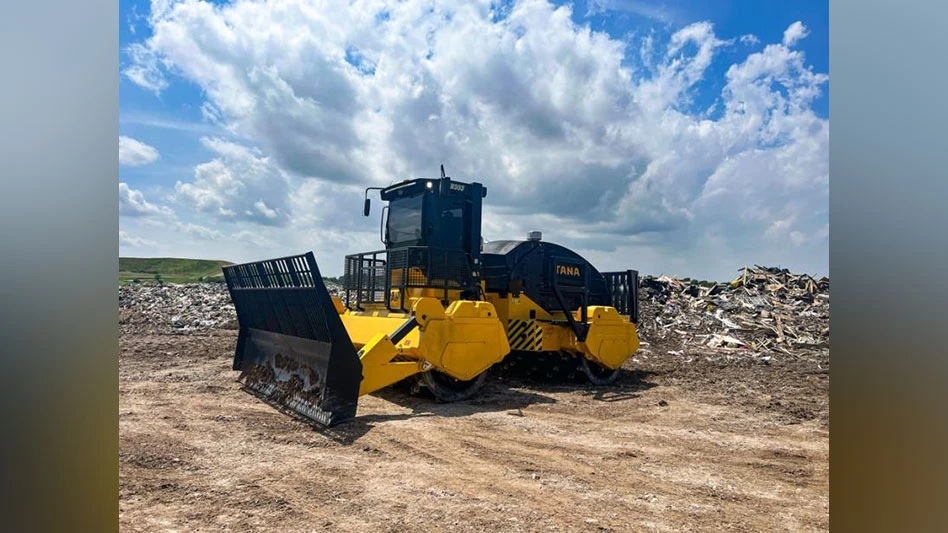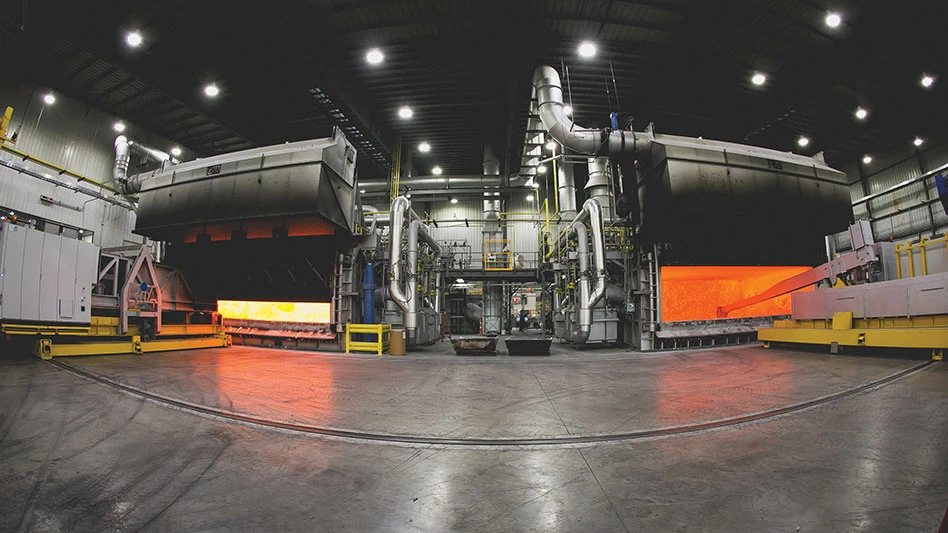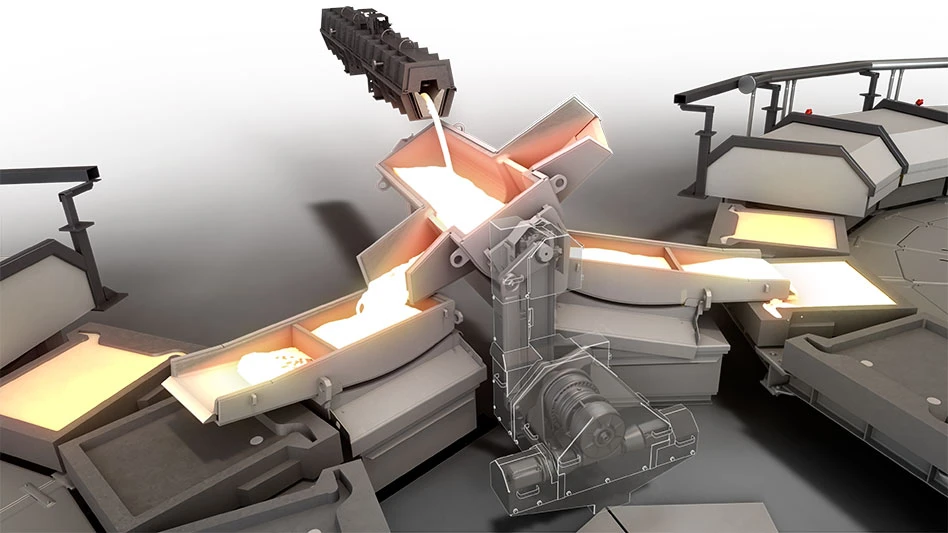Like a lonely UBC in a powerful crusher, primary aluminum markets got squished at the New Year.
The LME (London Metals Exchange) price for aluminum hit a 16-year low of $1,800 per ton. This was an abrupt turn-around for a material that actually was up more than 20 percent in 2004.
Somewhat more slowly, the market started to work its way back up. While the dip was an unpleasant surprise, the fundamentals for aluminum scrap seem to have remained in good shape.
Markets for automotive scrap and industrial extrusion grades all reacted to the LME drop. But there were some bright spots, depending on the product. Most secondary grades, including UBCs, held their own, independent of the LME market.
NOT SPECULATING. "Primary grades will follow the LME penny for penny," says Joel Fogel, nonferrous operations manager with Cohen Bros., Middletown, Ohio. "Secondary grades are more independent, more related to supply and demand."
Fogel says material flow was strong at Cohen Bros.’ processing facilities. That was good news for most segments of the secondary aluminum market when exchange-based prices took a beating.
"As strong as the dollar gets, the price for aluminum will get weaker," says Mitchell Goldberg, secretary of Northeast Metal Traders, Philadelphia. Like other observers, Goldberg pegs the relative disappearance of the China market as the underlying cause for the price slump on the LME.
Matt Kripke, vice president of Kripke Enterprises Inc., a brokerage based in Toledo, Ohio, agrees. "A stronger dollar will weaken prices on the LME," he says.
However, he sees that formula forcing scrap spreads together even more. "The LME price may drop, but I don’t think scrap will drop as much," he says.
Another reason for the dip can be credited to a correction after markets went sky high. After the drop-off, the LME moved back up, recovering a little—but not all—of its loss.
This happened at a time when people often hold material until after the first of the year. The New Year brought some of the usual tax selling. High ferrous prices obviated any need to sell other products.
On the East Coast, Michael Dorfman, State Metal Industries, Camden, N.J., says that, at the beginning of the year, people appeared to be holding material back. "Scrap is somewhat tight. There are some old export orders still lying around."
Like others, he notes the strength of the ferrous markets and says that many people don’t have a need to ship material to keep cash flowing. "But pricing is still strong, overall, compared to previous years," he adds. "Scrap is still flowing."
Allied Metal Industries, Chicago, purchases about 10 million pounds of material per month, regardless of where the LME is headed.
"We’ve seen no specific reaction [to the LME price drop]," says Barry Cohen, vice president of purchasing. "As a secondary smelter, we did not follow the price up to $1,900-plus. We’re holding where we have been."
At Schupan & Sons, Kalamazoo, Mich., nonferrous marketing manager Jay Sherwood saw the December slump as "a non-existent event for us." It was like it happened in a parallel universe.
"From what I’ve seen, it was the financial markets that crumbled," he says. "We’ve seen strong demand for material." He notes that, by mid-January, prices already had recovered to where they were in late December.
ON THE GROUND. Sherwood is not so sure that China is to blame for the December slump. "The consuming market took it as an excuse to widen margins," he says. Like everyone else, he saw the raw material withdrawals and warrant cancellations. Yet it did not affect him. "We have had no problems with what little we sell to China," he says. And, on the domestic side, he says, flow is steady.
"Flow is good," Kripke also says. "So far we have not noticed a drop-off." In fact, Kripke Enterprises has been extremely busy. "Sales are good. Demand for scrap is strong. In the wake of the LME falling off, the scrap spread tightened up quickly," Kripke adds.
Spreads tightened to as close as 2 or 3 cents on some items. "Volume looks normal to slightly above average," Kripke says. "I think that the flow of material is good. People are calling to schedule."
"There is a lot of scrap out there right now," says Stephen Moss, vice president of Stanton A. Moss, Bryn Mawr, Pa. "It seems there is more scrap than what the market needs—maybe a small glut on the market."
Like others, Moss dismisses the gyrations of the LME, noting that the "low" price in January came on the heels of a 10-year high in late 2004. "Not everyone is jumping at the [new] prices. But demand will continue to be strong for scrap and product is moving," he says.
"Material is flowing," agrees Letty Estrada, buyer at City Scrap Metal, Chicago. "The market has not hit us. Prices are staying strong."
Kripke, too, remains bullish on aluminum scrap. He says that the scrap market will drop only 2 cents for every 3 cents the LME falls. Of course, the market varies by product segment.
AUTOS STALLING. Dorfman, Gold-berg and Moss all say the auto market is not strong at all and are concerned that the weakness could have an impact.
"As long as manufacturing stays strong, things should not drop off any more," Dorfman says.
|
POP IN UBCs |
|
In the face of an otherwise uncertain market, Mitchell Goldberg, Northeast Metal Traders, Philadelphia, sees some reprieve in the beverage can business. "The price for UBCs is relatively strong," he says. Often, the UBC (used beverage container) market is a world of its own within the aluminum universe. This is one of those times. "We are still seeing demand in UBCs," says Goldberg. "Whether the LME is at $1,800 or $1,950, UBCs go along on their own. We’re still pushing UBCs through." Matt Kripke of Kripke Enterprises Inc., a Toledo-based brokerage, says that the UBC market and related over-the-scale markets like painted aluminum siding should remain fairly steady. The one exception might be a fall-off due to local weather conditions, but that is to be expected through the winter months. Meanwhile, recycling of UBCs seems to be holding its own. According to California Department of Conservation statistics, Californians recycled 5.8 billion California Refund Value bottles and cans from January to July, 2004 (the most recent statistics available). That is the highest six-month figure ever. The numbers for the first half of 2004 show recycling is up for aluminum, glass and plastic beverage containers. |
"The automotive market will be the key," Moss says. "In this industry, consumers are driven by the aluminum auto part demand. Most of the aluminum goes right back to the secondary and die cast industries."
Moss says anticipated demand for cars is off for the first half of 2005 compared to the second half of 2004. The anticipated consumption is quite a bit behind, which could leave the market with a sizable inventory. "If it continues, it will hurt scrap pricing dramatically," Moss says.
Sherwood acknowledges the weaker automotive market, but feels that there is recovery in the offing. "Right now, there is a slowdown," he says. "But I subscribe to the Inchworm Theory: We’ll see the front-end move, and it just takes a while for the back end to catch up."
Given that scenario, Moss would be happier. "If auto production picks up, it will be a good year for the secondary grades—cast, sheet and turnings," he says.
Sponsored Content
Redefining Wire Processing Standards
In nonferrous wire and cable processing, SWEED balances proven performance with ongoing innovation. From standard systems to tailored solutions, we focus on efficient recovery and practical design. By continually refining our equipment and introducing new technology, we quietly shape the industry—one advancement at a time.
Obsolete autos also play a role in the market. Auto shred is a high-volume item on the supply side, and as long as Americans are scrapping obsolete cars at a fast pace, this will keep the twitch supply strong.
EXTRUSIONS. "Extrusions and segregated alloys will march with the LME, regardless of the time of year," Kripke says. He says that industrial accounts produce material on a year-round basis and scrap production does not vary much.
"Metal is flowing, but the domestic need is minimal," Goldberg says. "There is little demand for extrusions. Siding is a dead item," he continues. "There is no demand at all. The market for extrusions is dead in the Northeast."
Scrap extrusion material can still be obtained, however. Estrada says his company’s flow of extrusions is the same as always. City Scrap Metal buys from peddlers and, outside of the weather-related slowdowns, business is fairly strong. Across the Midwest, snowstorms brought the usual slowdown in the over-the-transom market, but the downturn was no more than might be expected even if prices on the LME were strong.
"We are paying 45-48 cents per pound," Estrada says. She pegs the price for UBCs at 42-45 cents. "We buy all sorts of extrusions, UBCs, painted siding, clips—dirty or clean, we buy it," she says.
The large industrial markets continued on an even keel. "I am looking for a decent year," says Allied’s Cohen. "We need to keep the ingot price up," he says, "but we are buying what we can get."
Fogel is bullish about the market, even deep into 2005. "Flow (in mid-January) is good. I expect flow to be consistent this year. We expect to be pretty busy," he says.
Moss notes that China is still quoting, though the pricing is not as attractive as it has been in the recent past. It is anyone’s guess what part of the slowdown is in light of China’s new regulations on importing material and what is due to the traditional shut-down for the Chinese New Year.
Fund participation remains another wild card in the game. Scrap does not necessarily follow the LME, but the exchange pricing does have a psychological effect on aluminum scrap markets.
"Scrap is out there, but it is not abundant," Dorfman says. He credits some of the tightness to the usual winter slowdown. "Spreads are tight since demand has dropped on the automotive end," Dorfman says. "That’s the one little black cloud over the industry. But overall, manufacturing seems to be in decent shape."
Moss wonders about a potential increase in the dollar value. "If the dollar gets even with the Euro, metal prices on the LME could go down 20 percent," he says. That would take $350-$375 off the price of some grades of aluminum, but it would not apply to all scrap.
Despite those caveats, Moss is optimistic. "I think there will continue to be strong demand for new production scrap," he says. He notes that 2004 was the first time in years that there was no decline in the production side of the industry. "Companies will be fighting for scrap," he expects.
Sherwood is also optimistic. "I think we’ll see a market that is steady to growing," he says. Since last year’s LME inventory drop, he has seen continued demand for material from consuming buyers.
"I don’t think the outlook is totally rosy, but I’m no Chicken Little, either," Sherwood says. "I see a steady-to-growing market," he concludes.
The author is a Recycling Today contributing editor based in Cleveland. He can be contacted at curt@curtharler.com.
Get curated news on YOUR industry.
Enter your email to receive our newsletters.

Explore the February 2005 Issue
Check out more from this issue and find your next story to read.
Latest from Recycling Today
- Fenix Parts acquires Assured Auto Parts
- PTR appoints new VP of independent hauler sales
- Updated: Grede to close Alabama foundry
- Leadpoint VP of recycling retires
- Study looks at potential impact of chemical recycling on global plastic pollution
- Foreign Pollution Fee Act addresses unfair trade practices of nonmarket economies
- GFL opens new MRF in Edmonton, Alberta
- MTM Critical Metals secures supply agreement with Dynamic Lifecycle Innovations








